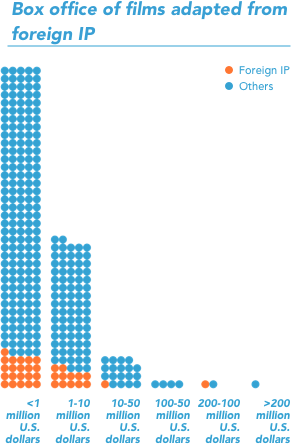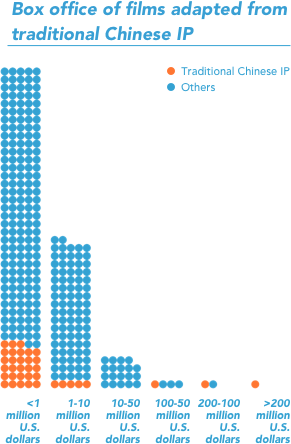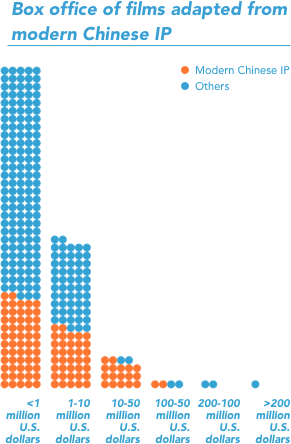
This project does not support this browser.
To continue using this page, you will need to use an alternative browser. We suggest one of the options below:
- Google Chrome
- Mozilla Firefox
- Safari

This project does not support this browser.
To continue using this page, you will need to use an alternative browser. We suggest one of the options below:






Data sources: Douban (Douban.com) and ChinaBoxOffice (Cbooo.cn)
Data is limited to Chinese animated films (including co-productions) released in the Chinese Mainland from October 1949 to August 2019.
Films must be over 40 minutes long and have animation in at least 75 percent of their running time, or have at least 40 minutes of animation in total.
Disclaimer: All movie posters and animation characters are copyright to their respective owners. For inquiries please contact c_lab@cgtn.com.
Supervisor: Jiang Heping. Managing Director: Zhang Shilei. Project Manager: Si Nan. Multimedia Producers: Xu Jiye, Zhou Rui. Interactive Designer: Li Yixiao. Interactive Developers: Duan Huiran (Intern), Bi Jiankun. Chief Editor: Chen Ran. Copy Editor: Nadim Diab. Copywriter: Wu Lushi. Data Editors & Visualization: Zhang Yujia, Li Yixiao, Zhou Rui, Duan Huiran (Intern)
*Note: Rankings of Chinese animated film box office in Chinese Mainland.



Chinese animated film "Ne Zha" has shattered records since its domestic debut on July 26, becoming the second highest-grossing film in the Chinese Mainland by August 31.
It is loosely based on the novel "Investiture of the Gods" and the latest exhibit in a long-running trend of using Intellectual Property (IP) in China's animation industry.


The most adapted IP genre in Chinese animated films is animated TV series (71 films in total).
The most used foreign IP characters are the Three Little Pigs and Snow White, with each adapted in 4 films.
The most adapted Chinese IP is "Journey to the West" which has been adapted 11 times in 13 films since 1949.
The most profitable animal character in China is the bear, with the "Boonie Bears" franchise raking in 274 million U.S. dollars since 1949.




"The Monkey King"
adapted from "Journey to the West"

"The Monkey King Conquers the Demon"
adapted from "Journey to the West"

"Lotus Lantern"
adapted from "The Magic Lotus Lantern"
"The New Pinocchio"
based on a fairy tale
"Alibaba and The Thief"
based on a folktale
"Tale of The Rally"
based on a fable


"Ne Zha"
No.1


"Monkey King: Hero is Back"
No.3


"White Snake"
No.7


"Boonie Bears" franchise
5 films in TOP 20


"Pleasant Goat and Big Big Wolf" franchise
5 films in TOP 20


"New Happy Dad and Son" franchise
2 films in TOP 20


Legend




Foreign IP
Traditional Chinese IP
Modern Chinese IP
Others
 Chinese IP
Chinese IP
 Foreign IP
Foreign IP
 Traditional Chinese IP
Traditional Chinese IP
 Modern Chinese IP
Modern Chinese IP
* Films adapted from
Chinese IP
* Films adapted from
foreign IP
* Films adapted from
traditional Chinese IP
* Films adapted from
modern Chinese IP
Before 2000, domestic IPs, mainly works of literature, inspired big-screen animations in China.

"The Monkey King"
adapted from
"Journey to the West"

"The Monkey King
Conquers the Demon"
adapted from
"Journey to the West"

"Lotus Lantern"
adapted from
"The Magic
Lotus Lantern"
The year 2000 witnessed a burgeoning shift in preferences as numbers of domestic IP adaptions began to drop.
Since 2013, foreign IPs became popular in Chinese IP films.
"The New Pinocchio"
based on a fairy tale
"Alibaba and The Thief"
based on a folktale
"Tale of The Rally"
based on a fable
Fairy tales, folktales and fables are good fodder for animated films not just in China. Of the 57 Disney animated productions, 46 are either based or inspired by these genres.
The "Kung Fu Panda" trilogy might be the most popular China-centric animation, but the franchise is a U.S. IP created by DreamWorks Animation. The 3rd installment, however, is a co-production between China and the U.S. and the most successful foreign IP adaptation, having hauled in 140 million U.S. dollars. But its exceptional performance is a breakaway success for foreign IP adaptations in the country.

Films adapted from classic literature and mythology are also more likely to become blockbusters.


"Ne Zha"
No.1


"Monkey King:
Hero is Back"
No.3


"White Snake"
No.7
*Note: Rankings of Chinese animated film box office in Chinese Mainland.
Traditional Chinese IPs have also found fame in overseas movie markets. Disney's "Mulan" is adapted from the poem "The Ballad of Mulan" and the "Dragon Ball" franchise is inspired by "Journey to the West."
The smashing success of "Monkey King: Hero is Back" brought to the fore the potential of traditional IP adaptations. Similar attempts followed but the feat of the 2015 film was hard to duplicate.

Films adapted from modern IP present a steadier box office performance in general than their traditional counterparts. These IPs are mostly original animated TV series or cartoon shows. Of the top 20 highest-grossing animated films in the Chinese Mainland, 12 are adapted from TV animations.


"Boonie Bears"
franchise
5 films in TOP 20


"Pleasant Goat and Big
Big Wolf"
franchise
5 films in TOP 20


"New Happy Dad
and Son"
franchise
2 films in TOP 20
It's not surprising that non-traditional IP films do relatively better since they benefit from the brand recognition of the IP and its existing audience base.

From relying on domestic IPs to experimenting with original storylines and foreign IP adaptations, Chinese animated films have reinvented themselves over 70 years of development. The phenomenal sensation brought by "Monkey King: Hero is Back" in 2015 has whetted the Chinese audience's appetite for a solid "Chinese story," while the megahit "Ne Zha" this year is fueling further explorations of local traditional IPs.
Copyright © 2018 CGTN. Beijing ICP prepared NO. 16065310-3
The End